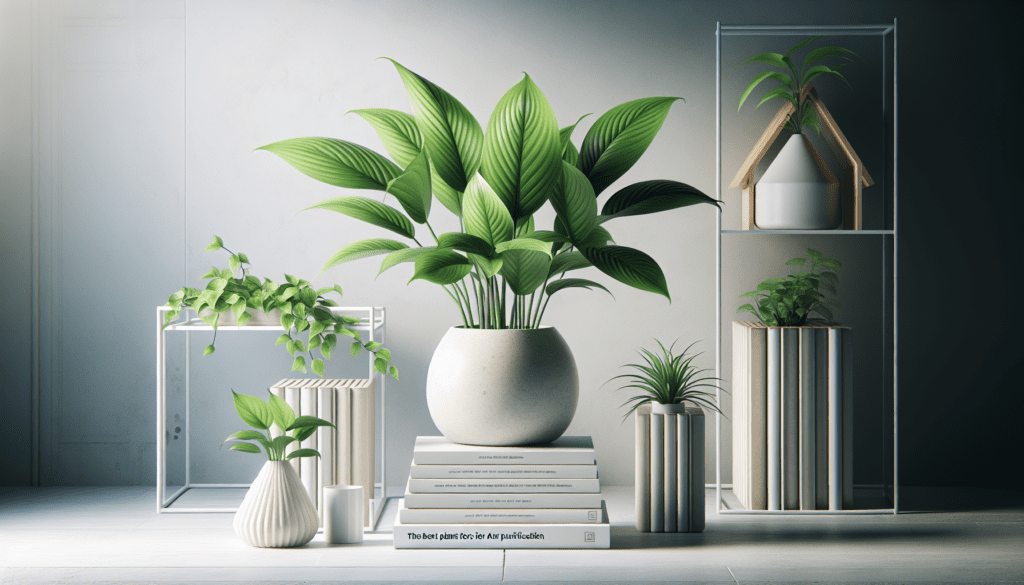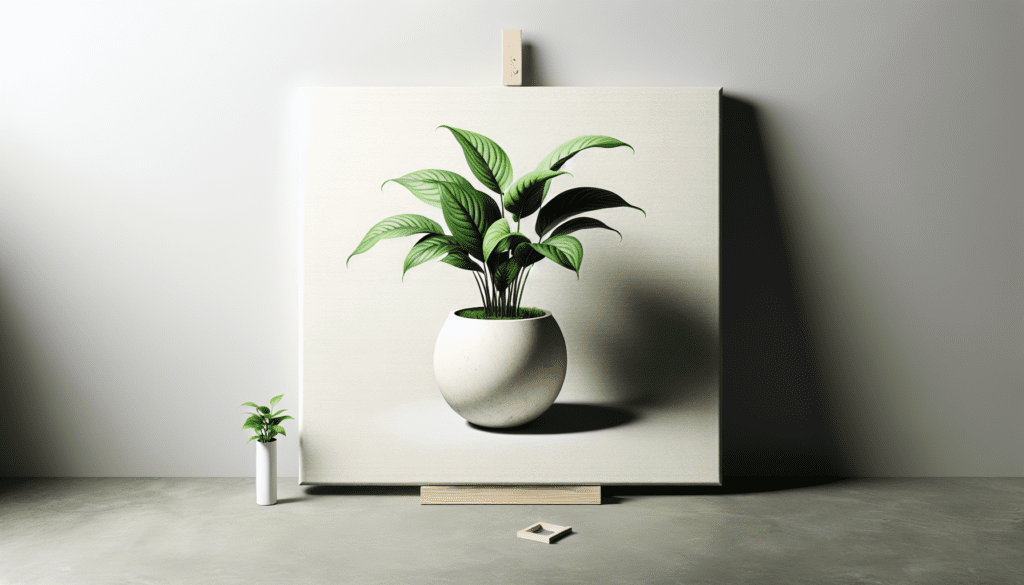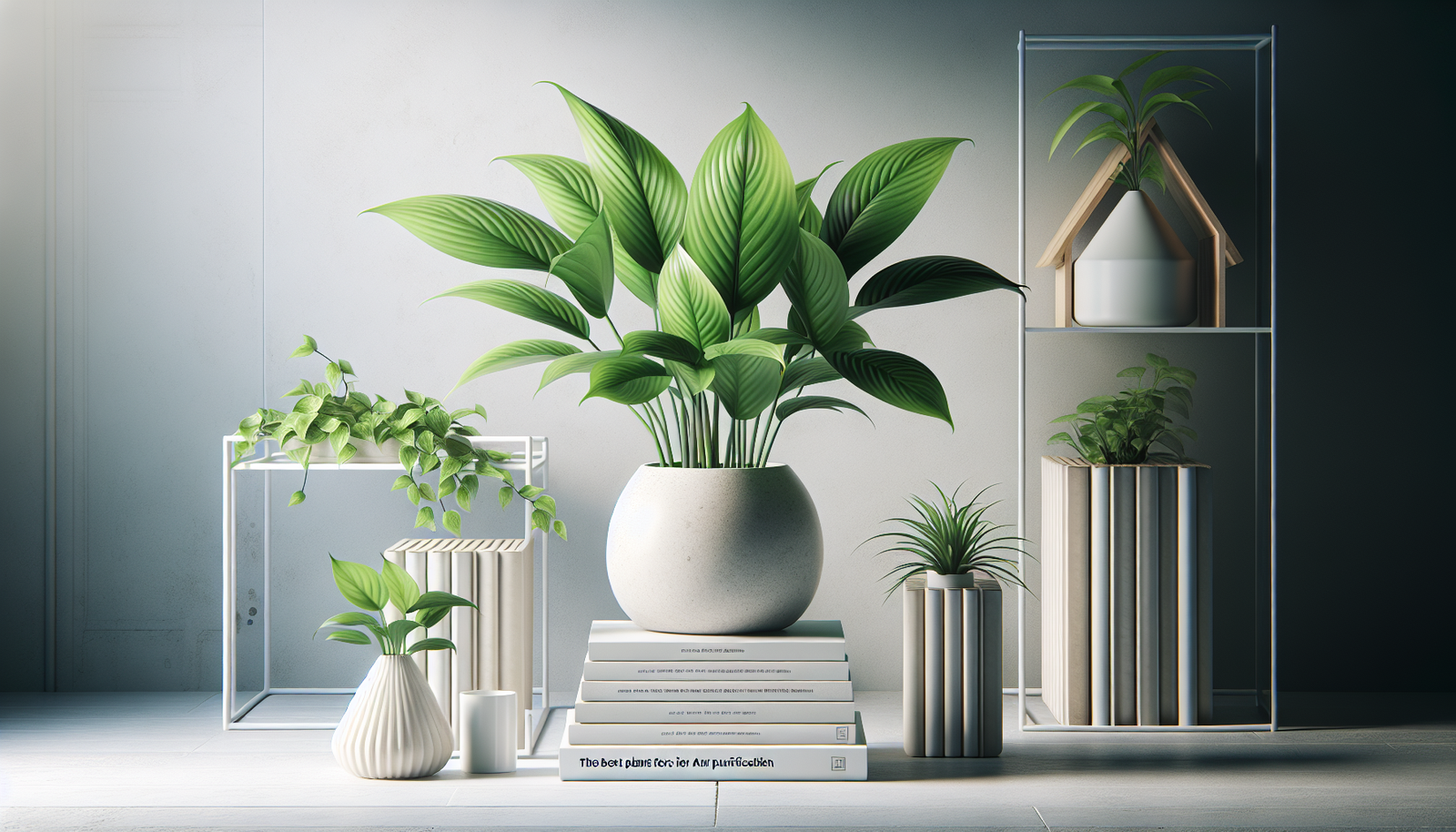Are you looking for a natural and effective way to improve the air quality in your home? Look no further than indoor plants! In this article, we will explore the best plants for air purification indoors. These green wonders not only add beauty and lushness to your space but also have the remarkable ability to filter out harmful toxins and pollutants, creating a healthier environment for you and your loved ones. From the classic English Ivy to the vibrant Peace Lily, discover how these plants can transform your indoor space into a breath of fresh air.

Benefits of Indoor Plants for Air Purification
Indoor plants are not just beautiful additions to your home or office; they also play a crucial role in purifying the air you breathe. Here are some key benefits of having indoor plants for air purification:
Improving air quality
One of the primary benefits of indoor plants is their ability to improve air quality. They act as natural filters, removing toxins and pollutants from the air. Through a process known as phytoremediation, plants absorb harmful gases such as formaldehyde, benzene, and trichloroethylene, which are commonly found in indoor environments. By having plants in your space, you can significantly reduce the levels of these pollutants and improve the overall air quality.
Reducing toxins and pollutants
Apart from their role in removing harmful gases, indoor plants are also effective in reducing other indoor pollutants. Volatile Organic Compounds (VOCs), which are emitted by various household products like cleaning agents, paints, and furniture, can have detrimental effects on our health. However, studies have shown that certain indoor plants can effectively remove these toxins from the air, creating a healthier environment for you and your loved ones.
Increasing humidity levels
During the winter months or in dry climates, maintaining appropriate humidity levels indoors can be a challenge. Fortunately, certain plants have the ability to release moisture through a process called transpiration. By having these plants around, you can increase the humidity in your space, which can help alleviate dry skin, irritated eyes, and respiratory issues caused by dry air.
Boosting mood and productivity
In addition to their air-purifying abilities, indoor plants can also have positive effects on your mood and productivity. Research has shown that being surrounded by greenery can reduce stress levels, improve mood, and increase attention span. Whether you’re working from home or studying for exams, having indoor plants in your environment can create a calming and uplifting atmosphere, thereby enhancing your overall well-being and productivity.
Factors to Consider when Choosing Indoor Plants for Air Purification
When selecting indoor plants for air purification, it’s essential to consider several factors to ensure their effectiveness and suitability for your indoor environment. Here are some factors to keep in mind:
Effectiveness in air purification
Not all indoor plants have the same air-purifying capabilities. Some plants are more efficient at removing specific toxins than others. Before choosing an indoor plant, it’s important to research which pollutants it can effectively filter out. This will help you select plants that are best suited for your specific needs and the pollutants present in your indoor space.
Maintenance requirements
Different plants have different maintenance requirements, including watering frequency, light exposure, and temperature preferences. It’s essential to choose plants that align with your lifestyle and the amount of time you can dedicate to their care. If you have a busy schedule or lack experience with plant care, opt for low-maintenance plants that can thrive with minimal attention.
Suitability for indoor environments
Not all plants thrive indoors, especially in environments with low natural light or air conditioning. It’s crucial to choose plants that are well-suited for indoor conditions and can tolerate the specific lighting and temperature levels in your space. Consider factors such as the direction of natural light, potential drafts, and temperature fluctuations before selecting indoor plants.
Aesthetic appeal
While the primary purpose of indoor plants is air purification, their aesthetic appeal should not be overlooked. Choose plants that align with your interior design style and complement the overall ambiance of your space. With a wide variety of indoor plants available, you can find options ranging from lush, leafy greens to colorful flowering plants, ensuring both air purification and visual appeal.
The Top 10 Indoor Plants for Air Purification
Now that we’ve explored the benefits of indoor plants for air purification and the factors to consider, let’s take a closer look at the top 10 plants that are known for their air-purifying properties:
1. Aloe Vera
Aloe Vera is not only a popular plant for skincare but also excels in purifying the air. It effectively filters out formaldehyde, benzene, and other harmful chemicals commonly found in household products. Aloe Vera is easy to care for and can thrive in various light conditions, making it an ideal choice for air purification.
2. Spider Plant
Spider Plants are excellent air purifiers that remove pollutants such as formaldehyde and carbon monoxide. They are low-maintenance plants that thrive in bright, indirect light. Additionally, Spider Plants produce small offsets called “spiderettes,” which can be propagated to create more greenery in your space.
3. Peace Lily
Peace Lilies are known for their elegant white flowers and their ability to remove harmful chemicals like formaldehyde, benzene, and trichloroethylene from the air. They prefer low-light conditions and are relatively easy to care for, making them a popular choice for indoor air purification.
4. Snake Plant
Snake Plants, also known as Mother-in-Law’s Tongue, are known for their striking upright leaves. They are efficient in filtering out toxins and pollutants like benzene, formaldehyde, xylene, and trichloroethylene. Snake Plants are incredibly sturdy and can tolerate low light and infrequent watering.
5. English Ivy
English Ivy is a versatile plant that can be grown indoors or outdoors. It is effective in removing formaldehyde, benzene, and xylene from the air. English Ivy prefers bright, indirect light and moderate watering. Its trailing vines can be a beautiful addition to hanging baskets or used as decoration for shelves and mantels.
6. Bamboo Palm
Bamboo Palms are excellent at removing indoor air pollutants like formaldehyde, benzene, and trichloroethylene. They thrive in bright, indirect light and require well-draining soil. Bamboo Palms can add a touch of tropical elegance to any space with their feathery fronds and graceful presence.
7. Boston Fern
Boston Ferns are popular indoor plants known for their delicate fronds and air-purifying qualities. They effectively remove formaldehyde, xylene, and benzene from the air. Boston Ferns prefer bright, indirect light and moist soil. These plants can be hung in baskets or placed on stands, adding a touch of natural beauty to your home or office.
8. Rubber Plant
Rubber Plants are not only visually appealing with their shiny, deep green leaves, but they also have excellent air-purifying capabilities. They effectively remove formaldehyde from the air and prefer bright, indirect light. Rubber Plants require moderate watering and can grow into stunning statement pieces in your indoor space.
9. Dracaena
Dracaenas come in various species, all of which contribute to air purification. They effectively filter out chemicals like formaldehyde, trichloroethylene, and benzene. Dracaenas are easy to care for and can tolerate a range of light conditions, making them a versatile choice for any indoor space.
10. Chinese Evergreen
Chinese Evergreens are low-maintenance plants that excel in filtering formaldehyde and benzene from the air. They prefer low to medium light levels and thrive in humid conditions. Chinese Evergreens come in different varieties, each displaying unique leaf patterns, making them not only beneficial but aesthetically pleasing as well.
Aloe Vera
Benefits of Aloe Vera for Air Purification
Aloe Vera is more than just a soothing gel for sunburns; it also provides significant benefits when it comes to air purification. This succulent plant is highly effective at removing formaldehyde, benzene, and other harmful chemicals that are commonly found in indoor environments. By having Aloe Vera in your home or office, you can create a cleaner and healthier atmosphere.
Care and Maintenance Tips
Aloe Vera is a relatively easy plant to care for, even for those with limited gardening experience. It thrives in bright, indirect light, so placing it near a window is ideal. However, it can also tolerate moderate levels of light. Aloe Vera prefers well-draining soil, so make sure to choose a pot with proper drainage holes.
Water your Aloe Vera plant sparingly, allowing the soil to dry out between waterings. Overwatering can lead to root rot, so it’s always better to err on the side of underwatering. Aloe Vera is a succulent, which means it stores water in its leaves, making it more tolerant of drought-like conditions.
During the growing season, which is spring and summer, fertilize your Aloe Vera plant once a month with a balanced, water-soluble fertilizer. This will provide the necessary nutrients for healthy growth. Trim off any dead or damaged leaves to keep the plant looking its best.
Following these care tips will ensure that your Aloe Vera thrives and continues to purify the air in your indoor space effectively.

Spider Plant
Benefits of Spider Plant for Air Purification
Spider Plants are renowned for their air-purifying abilities, making them an excellent choice for indoor environments. They effectively filter out formaldehyde, carbon monoxide, and other harmful substances commonly present in indoor air. By having a Spider Plant in your space, you can enjoy cleaner and fresher air.
Care and Maintenance Tips
Spider Plants are known for their resilience and adaptability, making them perfect for both experienced and novice plant enthusiasts. They prefer bright, indirect light but can tolerate lower light levels as well. Avoid placing them in direct sunlight, as it may scorch the leaves.
Water your Spider Plant when the top inch of the soil feels dry to the touch. Ensure that the pot has proper drainage to prevent root rot. Spider Plants can tolerate some drought, so it’s better to underwater than to overwater. During the summer months, mist the leaves occasionally to provide some humidity.
Spider Plants produce “spiderettes,” small offsets that can be propagated and grown into new plants. These spiderettes can be gently detached from the parent plant and placed in water or soil to establish roots. This allows you to expand your collection or share the gift of clean air with friends and family.
With minimal care, your Spider Plant will continue to purify the air while adding beauty to your indoor space.
Peace Lily
Benefits of Peace Lily for Air Purification
Peace Lilies are not only stunning with their elegant white flowers but also highly effective at purifying the air. They are known for their ability to filter out formaldehyde, benzene, trichloroethylene, and other harmful pollutants commonly found in indoor environments. Having a Peace Lily in your home or office can greatly improve the air quality.
Care and Maintenance Tips
Peace Lilies prefer low-light conditions, making them ideal for areas with limited access to natural light. However, they can also tolerate bright, indirect light. Avoid placing them in direct sunlight, as it can cause leaf burn.
When it comes to watering, Peace Lilies like to be kept evenly moist. Water the plant when the top inch of the soil feels dry, but avoid overwatering or letting the plant sit in standing water. Peace Lilies will droop when they need water, but they quickly recover after being watered.
In terms of humidity, Peace Lilies appreciate higher levels. Placing the plant on a tray filled with water and pebbles or using a humidifier can help create the ideal environment for the plant. Misting the leaves occasionally is also beneficial.
To keep your Peace Lily looking its best, wipe the leaves gently with a damp cloth to remove dust and promote optimal photosynthesis. Trim off any yellow or brown leaves to maintain the plant’s overall health and appearance.
Following these care tips will ensure that your Peace Lily thrives and continues to cleanse the air in your indoor space.
Snake Plant
Benefits of Snake Plant for Air Purification
Snake Plants, with their striking appearance and robust nature, are excellent air purifiers. They effectively remove formaldehyde, benzene, xylene, and trichloroethylene from the air, making them valuable additions to any indoor space. Snake Plants not only enhance the aesthetic appeal of your environment but also contribute to a healthier atmosphere.
Care and Maintenance Tips
Snake Plants are known for their ability to thrive in a range of conditions, making them perfect for beginners or those with less time to dedicate to plant care. They can withstand low light levels but also tolerate brighter indirect light. However, direct sunlight should be avoided as it can scorch the leaves.
When it comes to watering, Snake Plants prefer to be on the drier side. Allow the soil to dry out between waterings, as overwatering can cause the roots to rot. Snake Plants have succulent-like leaves that store water, allowing them to withstand periods of drought.
Snake Plants are relatively low maintenance, but they can benefit from occasional dusting. Use a damp cloth or a soft brush to gently remove any dust that may accumulate on the leaves. Trimming off any damaged or yellow leaves can also help maintain the plant’s health and appearance.
By providing your Snake Plant with the right conditions and minimal care, you can enjoy its air-purifying benefits for years to come.
English Ivy
Benefits of English Ivy for Air Purification
English Ivy, with its cascading vines and lush green leaves, is not only visually appealing but also highly effective at purifying the air. It efficiently filters out formaldehyde, benzene, and xylene, making it a valuable addition to any indoor space. English Ivy is both beneficial for air quality and adds a touch of natural beauty to your environment.
Care and Maintenance Tips
English Ivy prefers bright, indirect light but can tolerate lower light levels as well. Avoid placing it in direct sunlight, as it may scorch the leaves. English Ivy is adaptable and can thrive in different lighting conditions, making it suitable for various indoor spaces.
When it comes to watering, English Ivy prefers moist soil but can tolerate slight drying out between waterings. Ensure that the pot has proper drainage to prevent root rot. During the summer months, misting the leaves can help increase humidity levels and prevent them from drying out.
Allowing your English Ivy to trail or climb will help showcase its natural beauty. Consider placing it in a hanging basket, allowing the vines to cascade gracefully, or train it to climb a trellis or wall. As the plant grows, you may need to prune or trim to control its size and promote healthy growth.
With proper care and attention, your English Ivy will continue to improve the air quality and add a touch of elegance to your indoor space.
Bamboo Palm
Benefits of Bamboo Palm for Air Purification
Bamboo Palms are not only aesthetically pleasing with their feathery fronds but also excellent at purifying the air. They effectively filter out formaldehyde, benzene, and trichloroethylene, creating a healthier indoor environment. Having a Bamboo Palm in your space can enhance air quality while adding a touch of tropical beauty.
Care and Maintenance Tips
Bamboo Palms thrive in bright, indirect light and prefer slightly cooler temperatures. Avoid placing them in direct sunlight, as it may scorch the leaves. Additionally, they appreciate higher humidity levels, so misting the leaves occasionally or using a humidifier can help create the ideal conditions.
Water your Bamboo Palm when the top inch of soil feels dry to the touch. Ensure that the pot has proper drainage to prevent waterlogging, as it can lead to root rot. Avoid overwatering or allowing the plant to sit in standing water. Bamboo Palms can tolerate some drought but prefer to be kept evenly moist.
Fertilizing your Bamboo Palm every two to three months during the growing season, which is spring and summer, can provide additional nutrients for optimal growth. Use a balanced, water-soluble fertilizer specifically designed for houseplants.
To maintain the beauty of your Bamboo Palm, wipe the leaves periodically with a damp cloth to remove dust and promote healthy growth. Prune any yellow or brown leaves to keep the plant looking its best.
By following these care tips, you can ensure that your Bamboo Palm thrives and continues to improve air quality in your indoor space.
Conclusion
In conclusion, indoor plants provide numerous benefits when it comes to air purification. They improve air quality by filtering out toxins and pollutants, increase humidity levels, and even boost mood and productivity.
When choosing indoor plants for air purification, consider their effectiveness in removing specific pollutants, maintenance requirements, suitability for indoor environments, and aesthetic appeal. By selecting the right plants, you can enjoy both cleaner air and an aesthetically pleasing environment.
The top 10 indoor plants for air purification include Aloe Vera, Spider Plant, Peace Lily, Snake Plant, English Ivy, Bamboo Palm, Boston Fern, Rubber Plant, Dracaena, and Chinese Evergreen. Each of these plants has unique air-purifying qualities and care requirements.
By providing proper care and attention, these indoor plants can effectively purify the air in your space, creating a healthier and more enjoyable environment for you and your loved ones. So why not bring some nature indoors and experience the benefits of indoor plants for air purification today?

